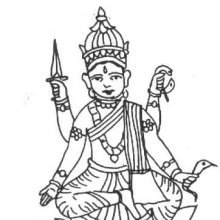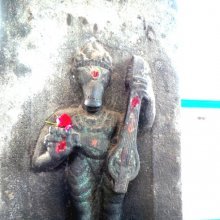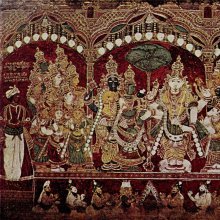Tumburu, Tuṃburu: 24 definitions
Introduction:
Tumburu means something in Buddhism, Pali, Hinduism, Sanskrit, Jainism, Prakrit, biology. If you want to know the exact meaning, history, etymology or English translation of this term then check out the descriptions on this page. Add your comment or reference to a book if you want to contribute to this summary article.
Images (photo gallery)
In Hinduism
Purana and Itihasa (epic history)
Source: archive.org: Puranic Encyclopedia1) Tumburu (तुम्बुरु).—A Deva Gandharva. He was the best musician among the Gandharvas. Birth. Tumburu was the son of Kaśyapa, son of Marīci and grandson of Brahmā, born of his wife Pradhā. Of the sons of Kaśyapa the four Gandharva sons, Tumburu, Bāhu, Hāhā and Hūhū were noted for their sweet and pleasant conversation. (See full article at Story of Tumburu from the Puranic encyclopaedia by Vettam Mani)
2) Tumburu (तुम्बुरु).—A sage. Some details.
2) (i) This sage was one among the many sages who came from the north to visit Śrī Rāma on his return to Ayodhyā after the exile. Those who came from the north were—Kaśyapa, Vasiṣṭha, Atri, Viśvāmitra, Gautama, Jamadagni, Bharadvāja, Sanakādis, Śarabhaṅga, Durvāsas, Mataṅga, Vibhāṇḍaka and Tumburu. (Uttara Rāmāyaṇa).
2) (ii) Tumburu was one among the ṛṣis who visited Bhīṣma lying on his bed of arrows. (Chapter 47, Śānti Parva).
Source: archive.org: Shiva Purana - English TranslationTumburu (तुम्बुरु) is the name of a Gandharva king who caused the Śivapurāṇa to be narrated in the Vindhya mountain range, as mentioned in the Śivapurāṇa-māhātmya chapter 5.—Accordingly, as Girijā (Pārvatī) said: “[...] O Tumburu, the favourite of Śiva, ever ready to do as I wish, blessedness be thine. Accompany this lady immediately to Vindhya mountain. There is an awfully terrible Piśāca there. [...] After undergoing the tortures of many hells, the wicked wretch is now roaming in the Vindhya mountain as a roguish sinful Piśāca. Narrate the holy sanctifying tale of sacred Śivapurāṇa, that quells all sins, in front of him. Immediately after hearing the great story of Śivapurāṇa his soul will be cleared of sins and he will cast off his ghosthood. [...] Tumburu, the comrade of Nārada, went to the Vindhya mountain seated in the aerial chariot in the company of Cañculā, the sinless woman and saw the Piśāca laughing, crying and loudly shouting by turns. [...] Thereafter, for the sake of the discourse on Śivapurāṇa, Tumburu made elaborate festive arrangements. There was much talk and discussion among the people of all the worlds ‘‘Oh, Tumburu has gone to the Vindhya mountain at the suggestion of Goddess, to narrate the story of Śivapurāṇa to redeem the Piśāca’ [...]”.
Source: Cologne Digital Sanskrit Dictionaries: The Purana Index1a) Tumburu (तुम्बुरु).—An expert in divine music; had two daughters Manovatī and Sukeśā;1 a friend of Candrodaka dundubhī.2 A Gandharva disciple of Nārada, came with the sage to see Yudhiṣṭhira, and returned to heaven with him;3 sang with Nārada the glories of Ananta;4 praised Hiraṇyakaśipu when he became the overlord of all worlds.5 Sang the praise of Kṛṣṇa when he held the Govardhana;6 presiding over the months of Madhu and Mādhava.7 His two daughters were celebrated as Pañcacūḍas;8 residing in the Sun's chariot in the months of Caitra and Madhu.9
- 1) Vāyu-purāṇa 69. 47, 49.
- 2) Ib. 96. 117.
- 3) Bhāgavata-purāṇa I. 13. 37 and 59.
- 4) Ib. V. 25. 8.
- 5) Ib. VII. 4. 14.
- 6) Ib. X. 25. 32; 27. 24.
- 7) Ib. XII. 11. 33; Brahmāṇḍa-purāṇa II. 23. 4.
- 8) Ib. III. 7. 9; IV. 20. 50 and 101.
- 9) Vāyu-purāṇa 52. 3; 36. 47; Viṣṇu-purāṇa II. 10. 3.
1b) A friend of Anu, son of Kapotaroma.*
- * Bhāgavata-purāṇa IX. 24. 20.
1c) A friend of Andhaka.*
- * Brahmāṇḍa-purāṇa III. 71. 118.
Tumburu (तुम्बुरु) was a gandharva (demi god) who, owing to a curse, became a demon (yakṣa). Tumburu, in the service of Kubera, lord of treasures, happens to see Rambhā, one of the celestial nymphs and falls in love with her. He tries his luck on her. Being not happy with the attitude of Tumburu, Vaiśravaṇa, another name of Kubera, curses him to become a terrific demon. On realising his mistake Tumburu begs to Kubera to put a term to the curse. Vaiśravaṇa that is Kubera tells him that he Tumburu (or Virādha) will have an encounter with Rāma and when the latter cuts off his (Virādha’s) arms, he will be relieved from his curse. Till then he will wander in the forest under the name of Virādha.
Source: JatLand: List of Mahabharata people and placesTumburu (तुम्बुरु) is a name mentioned in the Mahābhārata (cf. I.59.49, I.65, II.48.23) and represents one of the many proper names used for people and places. Note: The Mahābhārata (mentioning Tumburu) is a Sanskrit epic poem consisting of 100,000 ślokas (metrical verses) and is over 2000 years old.

The Purana (पुराण, purāṇas) refers to Sanskrit literature preserving ancient India’s vast cultural history, including historical legends, religious ceremonies, various arts and sciences. The eighteen mahapuranas total over 400,000 shlokas (metrical couplets) and date to at least several centuries BCE.
Shilpashastra (iconography)
Source: Archaeological Survey of India: Śaiva monuments at Paṭṭadakal (śilpa)Tumburu (तुम्बुरु) is depicted as part of a Naṭarāja sculpture on the third pillar of the southern half of the maṇḍapa of the temple of Lokeśvara.—Śiva dancing with his consort Umā is very well carved in the semi-circular medallion. By the side of Śiva is a figure with feet in the pose of vīrāsana, but the body and the head turned in ninety degrees towards Śiva. His head looks like that of a horse. We identify him with horse-headed Tumburu.

Shilpashastra (शिल्पशास्त्र, śilpaśāstra) represents the ancient Indian science (shastra) of creative arts (shilpa) such as sculpture, iconography and painting. Closely related to Vastushastra (architecture), they often share the same literature.
Natyashastra (theatrics and dramaturgy)
Source: archive.org: Natya ShastraTumburu (तुम्बुरु) is the name of an author of Sanskrit works dealing with music.—Some writers think on the basis of the occurrence of the expression ‘Tumburu-nāṭaka’ in Locana’s Rāga-taraṅgiṇī (12th century) that Tumburu wrote a play. But this tumburu-nāṭaka seems to have meant a kind of dance-drama originating with Tumburu.

Natyashastra (नाट्यशास्त्र, nāṭyaśāstra) refers to both the ancient Indian tradition (shastra) of performing arts, (natya—theatrics, drama, dance, music), as well as the name of a Sanskrit work dealing with these subjects. It also teaches the rules for composing Dramatic plays (nataka), construction and performance of Theater, and Poetic works (kavya).
Ayurveda (science of life)
Kalpa (Formulas, Drug prescriptions and other Medicinal preparations)
Source: Shodhganga: Edition translation and critical study of yogasarasamgrahaTumburu (तुम्बुरु) refers to the medicinal plant known as “Zanthoxylum armatum DC” and is dealt with in the 15th-century Yogasārasaṅgraha (Yogasara-saṅgraha) by Vāsudeva: an unpublished Keralite work representing an Ayurvedic compendium of medicinal recipes. The Yogasārasaṃgraha [mentioning tumburu] deals with entire recipes in the route of administration, and thus deals with the knowledge of pharmacy (bhaiṣajya-kalpanā) which is a branch of pharmacology (dravyaguṇa).

Āyurveda (आयुर्वेद, ayurveda) is a branch of Indian science dealing with medicine, herbalism, taxology, anatomy, surgery, alchemy and related topics. Traditional practice of Āyurveda in ancient India dates back to at least the first millenium BC. Literature is commonly written in Sanskrit using various poetic metres.
Shaivism (Shaiva philosophy)
Source: SOAS University of London: Protective Rites in the Netra TantraTumburu (तुम्बुरु) is the name of five-faced deity, according to the Netratantra of Kṣemarāja: a Śaiva text from the 9th century in which Śiva (Bhairava) teaches Pārvatī topics such as metaphysics, cosmology, and soteriology.—Accordingly, [verse 11.1-24ab, while describing the appearance and worship of Tumburu]—“Now, at this moment, I will tell the highest-most teaching to be worshipped with this mantra, for the sake of peace from all calamities, resulting in the fruits of all siddhis. [He worships] Deva as Tumburu in the middle of an eight petaled lotus, in the maṇḍala, [starting] in the East, O Devī. [The Sādhaka] honors the Lord who is ten-armed, five-faced, and three eyed, with the form and faces like Sadāśiva. [...]”.
Note: In 9.5-11, Tumburu is equated with Amṛteśa: “Amṛteśa is supreme. He is free of disease. [...] Because of him, splendid gems light up [differently] under different conditions, giving the fruits of all Āgamas in all streams. Thus, he is Śiva, Sadāśiva, Bhairava, Tumburu, Soma, and Sūrya, with his own form arising bearing no form”.

Shaiva (शैव, śaiva) or Shaivism (śaivism) represents a tradition of Hinduism worshiping Shiva as the supreme being. Closely related to Shaktism, Shaiva literature includes a range of scriptures, including Tantras, while the root of this tradition may be traced back to the ancient Vedas.
General definition (in Hinduism)
Source: Apam Napat: Indian MythologyTumburu is one of the prominent Gandharvas. He is well know for his skill in music, and has a very intimate relationship with the Apsara Rambha.
In Buddhism
Mahayana (major branch of Buddhism)
Source: archive.org: Bulletin of the French School of the Far East (volume 5)Tumburu (तुम्बुरु) is the name of a Goddess appointed as one of the Divine protector deities of Matura, according to chapter 17 of the Candragarbha: the 55th section of the Mahāsaṃnipāta-sūtra, a large compilation of Sūtras (texts) in Mahāyāna Buddhism partly available in Sanskrit, Tibetan and Chinese.—In the Candragarbhasūtra, the Bhagavat invites all classes of Gods and Deities to protect the Law [dharma?] and the faithful in their respective kingdoms of Jambudvīpa [e.g., the Goddess Tumburu in Matura], resembling the time of the past Buddhas.

Mahayana (महायान, mahāyāna) is a major branch of Buddhism focusing on the path of a Bodhisattva (spiritual aspirants/ enlightened beings). Extant literature is vast and primarely composed in the Sanskrit language. There are many sūtras of which some of the earliest are the various Prajñāpāramitā sūtras.
In Jainism
General definition (in Jainism)
Source: archive.org: Trisastisalakapurusacaritra1) Tumburu (तुम्बुरु) is the tree associated with the Gandharvas, one of the eight divisions of the Vyantaras: a group of deities living above the Ratnaprabhā-earth in the “lower world” (adhaloka), according to chapter 2.2 [ajitanātha-caritra] of Hemacandra’s 11th century Triṣaṣṭiśalākāpuruṣacaritra: an ancient Sanskrit epic poem narrating the history and legends of sixty-three illustrious persons in Jainism.
Accordingly: “[...] One thousand yojanas above Ratnaprabhā, with the exception of 100 yojanas above and below, live the eight classes of the Vyantaras in northern and southern rows within the 800 yojanas. In these are: [viz., the Gandharvas with the beautiful tumburu tree as lāñchana; ...]”.
2) Tumburu (तुम्बुरु) refers to the Yakṣa (i.e., messenger-deity) of Sumati, according to chapter 3.3.—Accordingly:—“In his tīrtha appeared the Lord’s messenger-deity, named Tumburu, white bodied, with a Garuḍa for a vehicle, one right hand holding a spear and one in varada-position, holding a mace and a noose in his left hands, always near at hand. likewise appeared Mahākālī, golden, with a lotus for a vehicle, one right hand in varada-position and one holding a noose, holding a citron and a goad in her left hands, the Lord’s messenger-deity, always near”.

Jainism is an Indian religion of Dharma whose doctrine revolves around harmlessness (ahimsa) towards every living being. The two major branches (Digambara and Svetambara) of Jainism stimulate self-control (or, shramana, ‘self-reliance’) and spiritual development through a path of peace for the soul to progess to the ultimate goal.
Biology (plants and animals)
Source: Google Books: CRC World Dictionary (Regional names)1) Tumburu in India is the name of a plant defined with Zanthoxylum acanthopodium in various botanical sources. This page contains potential references in Ayurveda, modern medicine, and other folk traditions or local practices It has the synonym Zanthoxylum alatum Roxb. (among others).
2) Tumburu is also identified with Zanthoxylum armatum It has the synonym Zanthoxylum alatum Roxb..
3) Tumburu is also identified with Zanthoxylum ovalifolium It has the synonym Fagara ovalifolia (Wight) Engler (etc.).
Example references for further research on medicinal uses or toxicity (see latin names for full list):
· Natural Product Research (2006)
· Illustrations of Indian Botany (1839)
· Journal of the Linnean Society, Botany (1905)
· Nomenclator Botanicus (1840)
· Journal of the Arnold Arboretum (1970)
· Phytochemistry (Oxford) (1973)
If you are looking for specific details regarding Tumburu, for example pregnancy safety, chemical composition, extract dosage, diet and recipes, health benefits, side effects, have a look at these references.

This sections includes definitions from the five kingdoms of living things: Animals, Plants, Fungi, Protists and Monera. It will include both the official binomial nomenclature (scientific names usually in Latin) as well as regional spellings and variants.
Languages of India and abroad
Sanskrit dictionary
Source: DDSA: The practical Sanskrit-English dictionaryTumburu (तुम्बुरु).—Name of a Gandharva.
Derivable forms: tumburuḥ (तुम्बुरुः).
See also (synonyms): tumbaru.
Source: Cologne Digital Sanskrit Dictionaries: Edgerton Buddhist Hybrid Sanskrit DictionaryTumburu (तुम्बुरु).—(in Sanskrit name of a gandharva), name of a yakṣa, brother of the four Kumārī, q.v., or Bhaginī: (Ārya-)Mañjuśrīmūlakalpa 523.11 (read Tumburoḥ); 534.1; 575.10; called a sārtha- vāha and karṇadhāra, 537.2; 538.1; et alibi in (Ārya-)Mañjuśrīmūlakalpa.
Source: Cologne Digital Sanskrit Dictionaries: Shabda-Sagara Sanskrit-English DictionaryTumburu (तुम्बुरु).—m.
(-ruḥ) 1. One of the Gandharbas or singers of heaven. 2. A celestial inhabitant and attendant upon the sanctified Jaina teachers. n. (-ru) Coriander. E. tubi to hurt, &c. uran affix; also with the pen. long tumbūru.
Source: Cologne Digital Sanskrit Dictionaries: Benfey Sanskrit-English DictionaryTumburu (तुम्बुरु).—I. m. The name of a Gandharva, [Rāmāyaṇa] 3, 8, 12. Ii. n. The fruit of Diospyros embryopteris Pers., [Suśruta] 2, 43, 2.
Source: Cologne Digital Sanskrit Dictionaries: Cappeller Sanskrit-English DictionaryTumburu (तुम्बुरु).—[masculine] [Name] of a Gandharva & [several] men.
Source: Cologne Digital Sanskrit Dictionaries: Monier-Williams Sanskrit-English Dictionary1) Tumburu (तुम्बुरु):—[from tumbura] m. Name of a pupil of Kalāpin, [Pāṇini 4-3, 104; Kāśikā-vṛtti] ([Kāraṇḍa-vyūha])
2) [v.s. ...] of a Gandharva, [Mahābhārata] etc. (‘attendant of the 5th Arhat of the present Avasarpiṇī’ [Jaina literature])
3) [v.s. ...] n. coriander or the fruit of Diospyros embryopteris (also rī and tubarī, [cf. Lexicographers, esp. such as amarasiṃha, halāyudha, hemacandra, etc.]), [Suśruta; iv; vi, 42, 67 and] (metrically rū) 118 [Pāṇini 6-1, 143; Kāśikā-vṛtti]
Source: Cologne Digital Sanskrit Dictionaries: Yates Sanskrit-English DictionaryTumburu (तुम्बुरु):—(ru) 1. n. Idem. m. A celestial chorister; celestial attendant.
[Sanskrit to German]
Sanskrit, also spelled संस्कृतम् (saṃskṛtam), is an ancient language of India commonly seen as the grandmother of the Indo-European language family (even English!). Closely allied with Prakrit and Pali, Sanskrit is more exhaustive in both grammar and terms and has the most extensive collection of literature in the world, greatly surpassing its sister-languages Greek and Latin.
Prakrit-English dictionary
Source: DDSA: Paia-sadda-mahannavo; a comprehensive Prakrit Hindi dictionaryTuṃburu (तुंबुरु) in the Prakrit language is related to the Sanskrit word: Tunburu.
Prakrit is an ancient language closely associated with both Pali and Sanskrit. Jain literature is often composed in this language or sub-dialects, such as the Agamas and their commentaries which are written in Ardhamagadhi and Maharashtri Prakrit. The earliest extant texts can be dated to as early as the 4th century BCE although core portions might be older.
Kannada-English dictionary
Source: Alar: Kannada-English corpusTuṃburu (ತುಂಬುರು):—[noun] the strong-smelling, seedlike fruit of the annual herb Coriandrum sativum of Umbellifarae family; coriander.
--- OR ---
Tuṃburu (ತುಂಬುರು):—
1) [noun] the tree Diospyros peregrina (= D. embryopteris, = D. glutenifera) of Ebenaceae family; Indian persimmon.
2) [noun] the tree Zanthoxylum armatum (= Z. alatum) of Rutaceae family.
--- OR ---
Tuṃburu (ತುಂಬುರು):—[noun] (myth.) name of a celestial singer.
Kannada is a Dravidian language (as opposed to the Indo-European language family) mainly spoken in the southwestern region of India.
See also (Relevant definitions)
Starts with: Tumburubhairavesha, Tumburuda, Tumburudu, Tumburuh, Tumburuphal, Tumburusu.
Ends with: Kakatumburu, Kiritumburu, Kiriyatumburu, Kustumburu, Kutumburu.
Full-text (+201): Tumbaru, Mangalavati, Viradha, Taumburava, Taumburavin, Tumbura, Kutumburu, Sphutaphala, Tumbara, Devarshi, Tunburu, Tumbur, Manuvanti, Kalavati, Tumburi, Candanodakadundubhi, Mangalavant, Sukeshi, Piratikai, Khadgacarmadhara.
Relevant text
Search found 42 books and stories containing Tumburu, Tuṃburu, Tumbūru; (plurals include: Tumburus, Tuṃburus, Tumbūrus). You can also click to the full overview containing English textual excerpts. Below are direct links for the most relevant articles:
Bhakti-rasamrta-sindhu (by Śrīla Rūpa Gosvāmī)
Verse 2.1.215 < [Part 1 - Ecstatic Excitants (vibhāva)]
The Skanda Purana (by G. V. Tagare)
Chapter 26 - The Greatness of Tuṃburu (Ghoṇa) Tīrtha < [Section 1 - Veṅkaṭācala-māhātmya]
Chapter 28 - The Glory of Sādhyāmṛtatīrtha: Purūravas Liberated from a Curse < [Section 1 - Setu-māhātmya]
Chapter 22 - The Efficacy of Listening to the Purāṇa < [Section 3 - Brāhmottara-khaṇḍa]
Trishashti Shalaka Purusha Caritra (by Helen M. Johnson)
Part 10: Description of a samavasaraṇa < [Chapter III]
Part 22: Sumatinātha’s messenger-deities (śāsanadevatās) < [Chapter III - Sumatināthacaritra]
Part 19: The Vyantaras < [Chapter III - The initiation and omniscience of Ajita]
Natyashastra (English) (by Bharata-muni)
Part 3 - Literature on Ancient Indian Music < [Introduction, Part 2]
Part 5 - Literature on the Ancient Indian Drama < [Introduction, part 1]
Part 7 - Data of India’s Cultural History in the Nāṭyaśāstra < [Introduction, part 1]
Puranic encyclopaedia (by Vettam Mani)
Chaitanya Bhagavata (by Bhumipati Dāsa)
Verse 1.1.52 < [Chapter 1 - Summary of Lord Gaura’s Pastimes]
Verse 3.10.45 < [Chapter 10 - The Glories of Śrī Puṇḍarīka Vidyānidhi]
Verse 1.1.74 < [Chapter 1 - Summary of Lord Gaura’s Pastimes]
Related products





